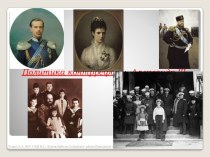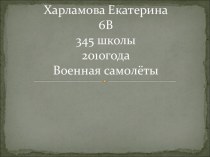- Главная
- Разное
- Бизнес и предпринимательство
- Образование
- Развлечения
- Государство
- Спорт
- Графика
- Культурология
- Еда и кулинария
- Лингвистика
- Религиоведение
- Черчение
- Физкультура
- ИЗО
- Психология
- Социология
- Английский язык
- Астрономия
- Алгебра
- Биология
- География
- Геометрия
- Детские презентации
- Информатика
- История
- Литература
- Маркетинг
- Математика
- Медицина
- Менеджмент
- Музыка
- МХК
- Немецкий язык
- ОБЖ
- Обществознание
- Окружающий мир
- Педагогика
- Русский язык
- Технология
- Физика
- Философия
- Химия
- Шаблоны, картинки для презентаций
- Экология
- Экономика
- Юриспруденция
Что такое findslide.org?
FindSlide.org - это сайт презентаций, докладов, шаблонов в формате PowerPoint.
Обратная связь
Email: Нажмите что бы посмотреть
Презентация на тему William the Conqueror
Содержание
- 2. ContentsIntroductionPhysical appearanceEarly lifeDuke of NormandyConquest of EnglandReignDeath,burial and succession
- 3. Introductionborn about 1028 in Falaise, died on
- 4. Physical appearanceNo authentic portrait was found, but
- 5. Early lifeBorn in Falaise, NormandyIllegitimate and only
- 6. Duke of NormandyWilliam succeeded his father as
- 7. Conquest of EnglandEnglish succession1066, after the dead
- 8. Conquest of EnglandNorman InvasionWilliam began to create
- 10. Conquest of EnglandBattle of HastingsOctober 14 –
- 11. Conquest of EnglandAgainst English resistanceThe south capitulated
- 12. Conquest of EnglandHarrying of the NorthWilliam dealed
- 13. ReignReformsIn 1086,the Domesday book was published (the
- 14. Death,burial and successionWhen William was besieging Mantes
- 16. Скачать презентацию
- 17. Похожие презентации
ContentsIntroductionPhysical appearanceEarly lifeDuke of NormandyConquest of EnglandReignDeath,burial and succession

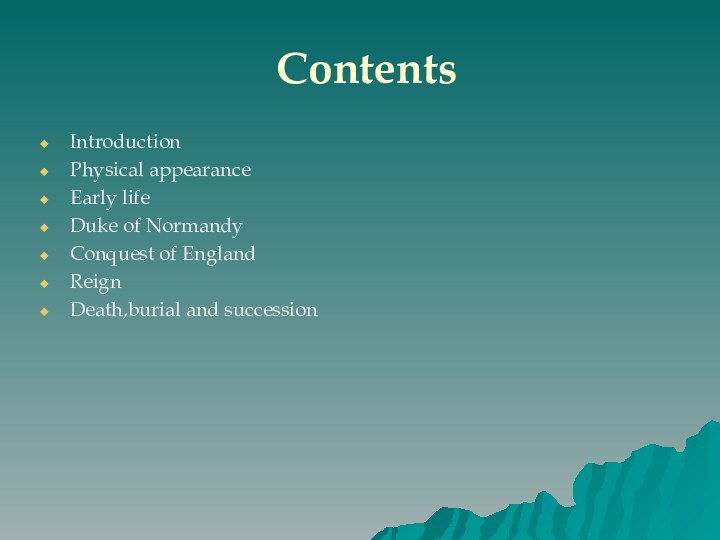
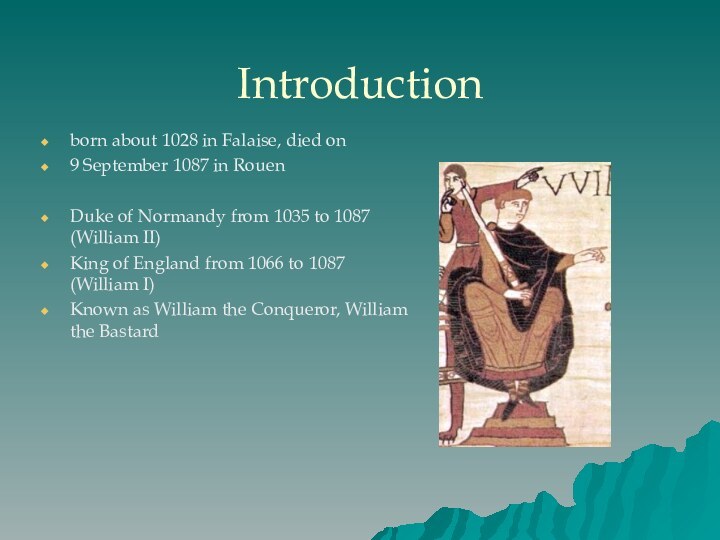

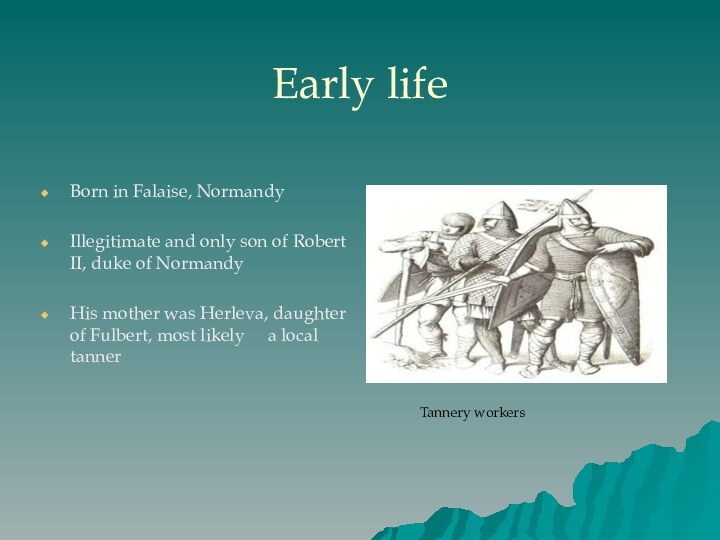

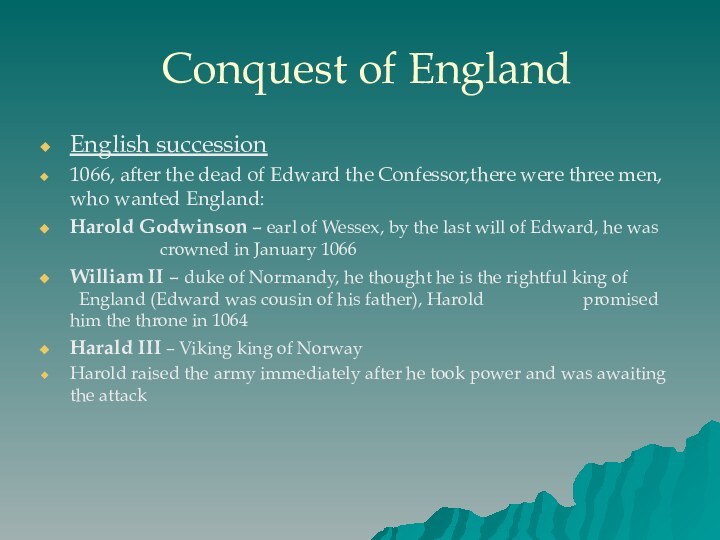

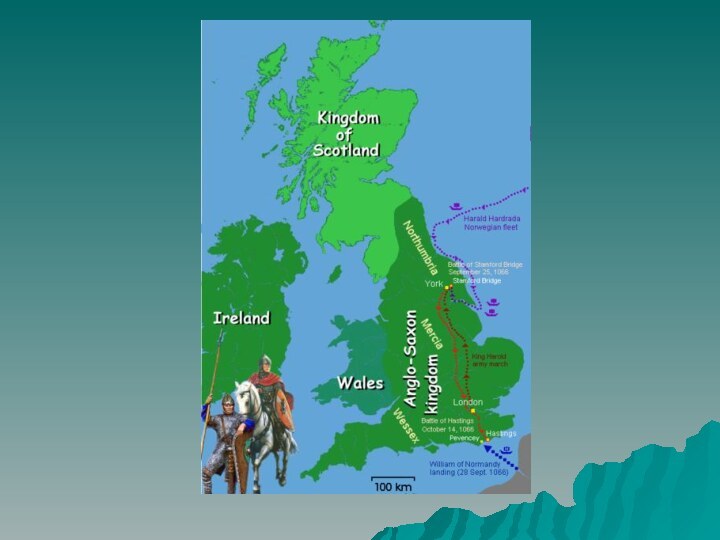
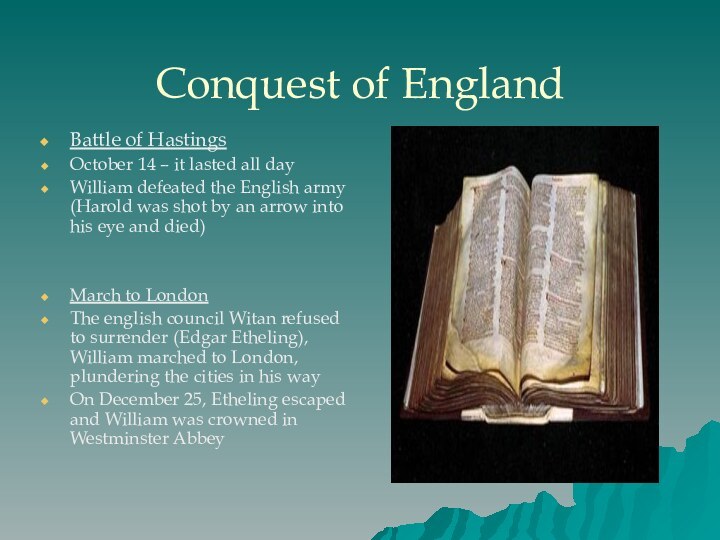
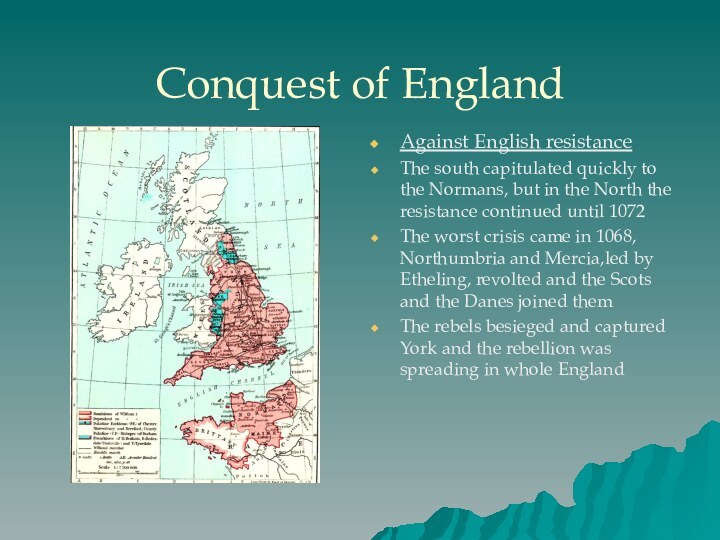
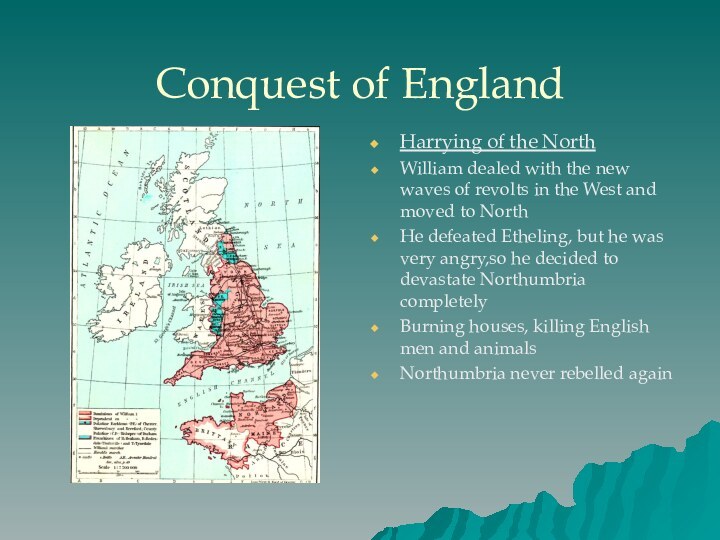
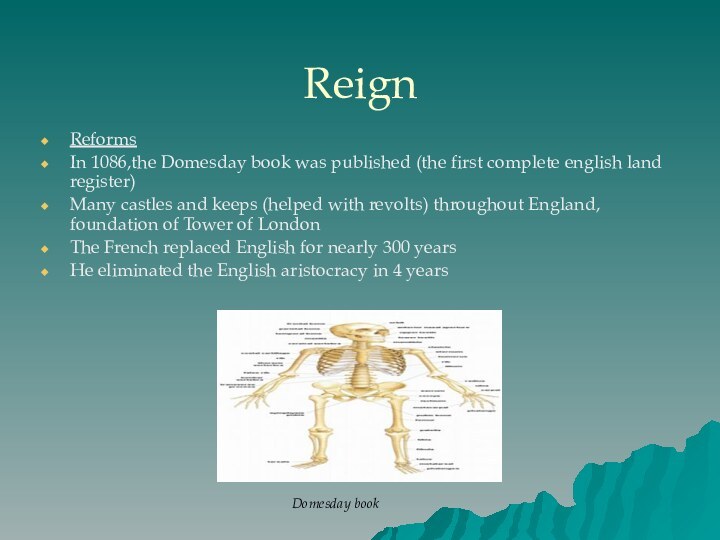

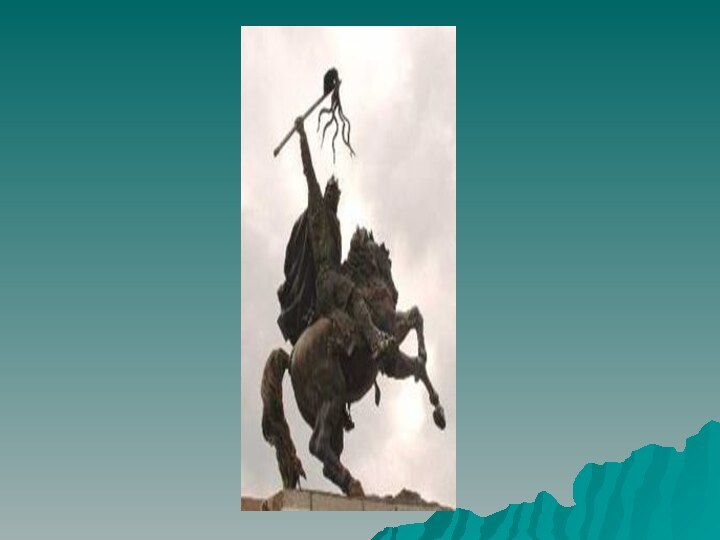

Слайд 2
Contents
Introduction
Physical appearance
Early life
Duke of Normandy
Conquest of England
Reign
Death,burial and
succession
Слайд 3
Introduction
born about 1028 in Falaise, died on
9
September 1087 in Rouen
Duke of Normandy from 1035 to
1087 (William II)King of England from 1066 to 1087 (William I)
Known as William the Conqueror, William the Bastard
Слайд 4
Physical appearance
No authentic portrait was found, but he
was described as a man of fair stature, with
very strong arms but with he was quite fatHis enemies commented,that he stinked like a tanner shop (occupation of his mother’s family)
Wax figure of William the Conqueror in Madame Tussaud's, London.
Слайд 5
Early life
Born in Falaise, Normandy
Illegitimate and only son
of Robert II, duke of Normandy
His mother was
Herleva, daughter of Fulbert, most likely a local tanner Tannery workers
Слайд 6
Duke of Normandy
William succeeded his father as Duke
of Normandy at the age of seven in 1035
The
Norman noblemen were trying to take his place, and three of William’s guardians were killedIn 1047, he defeated rebelling Norman
barons in the battle of Val-ès-Dunes and
united the Normandy
1053, he married his cousin Mathilda
(4 sons and 6 daughters)
Слайд 7
Conquest of England
English succession
1066, after the dead of
Edward the Confessor,there were three men, who wanted England:
Harold
Godwinson – earl of Wessex, by the last will of Edward, he was crowned in January 1066William II – duke of Normandy, he thought he is the rightful king of England (Edward was cousin of his father), Harold promised him the throne in 1064
Harald III – Viking king of Norway
Harold raised the army immediately after he took power and was awaiting the attack
Слайд 8
Conquest of England
Norman Invasion
William began to create a
new army (Normans, French mercenaries, many foreign knights)
The army
(600 ships and 7000 men) was waiting, the English channel was well-guarded by HaroldSeptember 8, Harold withdrew his army, because of falling morale and supplies
September 25 – slaughterous battle of Stamford Bridge (Harold defeated Harald III with Tostig Godwinson)
September 28 – William landed in England and moved to Hastings
Слайд 10
Conquest of England
Battle of Hastings
October 14 – it
lasted all day
William defeated the English army (Harold was
shot by an arrow into his eye and died)March to London
The english council Witan refused to surrender (Edgar Etheling), William marched to London, plundering the cities in his way
On December 25, Etheling escaped and William was crowned in Westminster Abbey
Слайд 11
Conquest of England
Against English resistance
The south capitulated quickly
to the Normans, but in the North the resistance
continued until 1072The worst crisis came in 1068, Northumbria and Mercia,led by Etheling, revolted and the Scots and the Danes joined them
The rebels besieged and captured York and the rebellion was spreading in whole England
Слайд 12
Conquest of England
Harrying of the North
William dealed with
the new waves of revolts in the West and
moved to NorthHe defeated Etheling, but he was very angry,so he decided to devastate Northumbria completely
Burning houses, killing English men and animals
Northumbria never rebelled again
Слайд 13
Reign
Reforms
In 1086,the Domesday book was published (the first
complete english land register)
Many castles and keeps (helped with
revolts) throughout England, foundation of Tower of LondonThe French replaced English for nearly 300 years
He eliminated the English aristocracy in 4 years
Domesday book
Слайд 14
Death,burial and succession
When William was besieging Mantes in
1087, he fell from a horse and cut his
colonAfter a few weeks , he died at the convent of St.Gervaise
Before his death, he divided his succession between his 3 sons:
Robert III – the oldest son got Normandy
William II – England
Henry I – he received 5000 silver pounds, after William’s death he became the English king
William was burried in Caen, but his grave was defiled twice (French wars of religion, the French Revolution)
Nowadays, only his left femur remains in the tomb


















